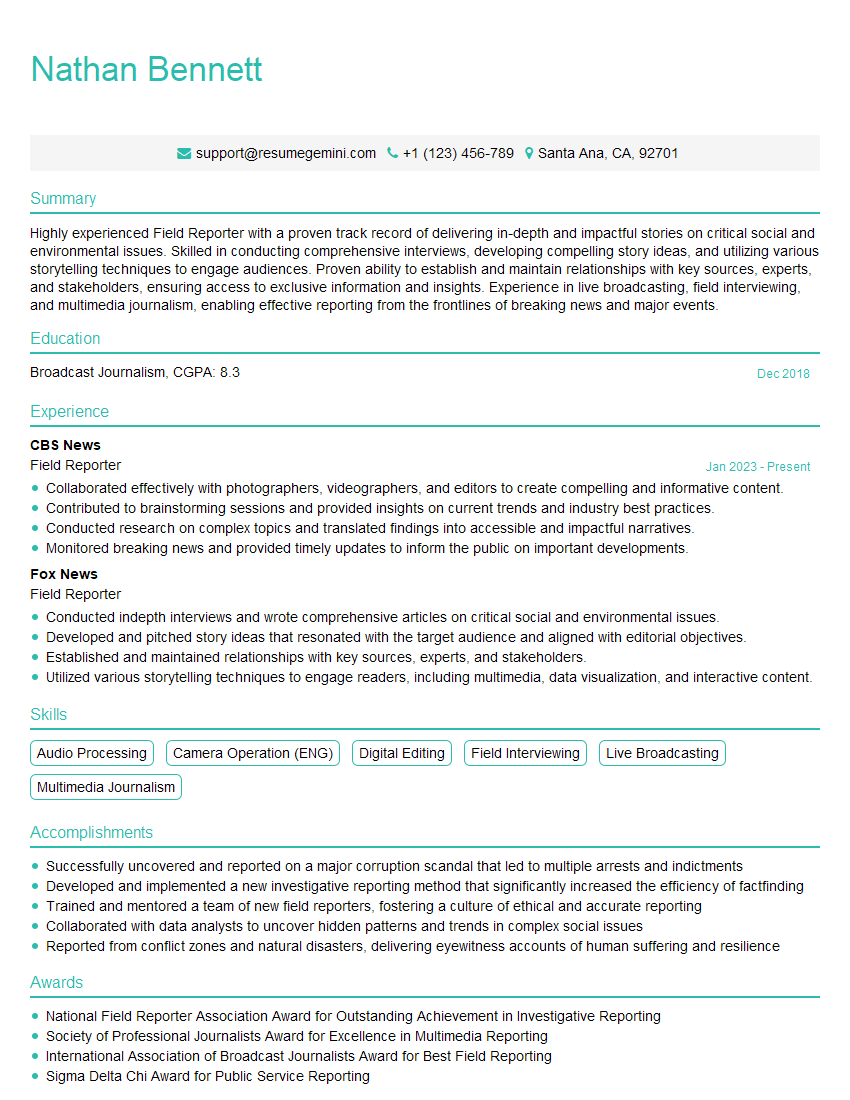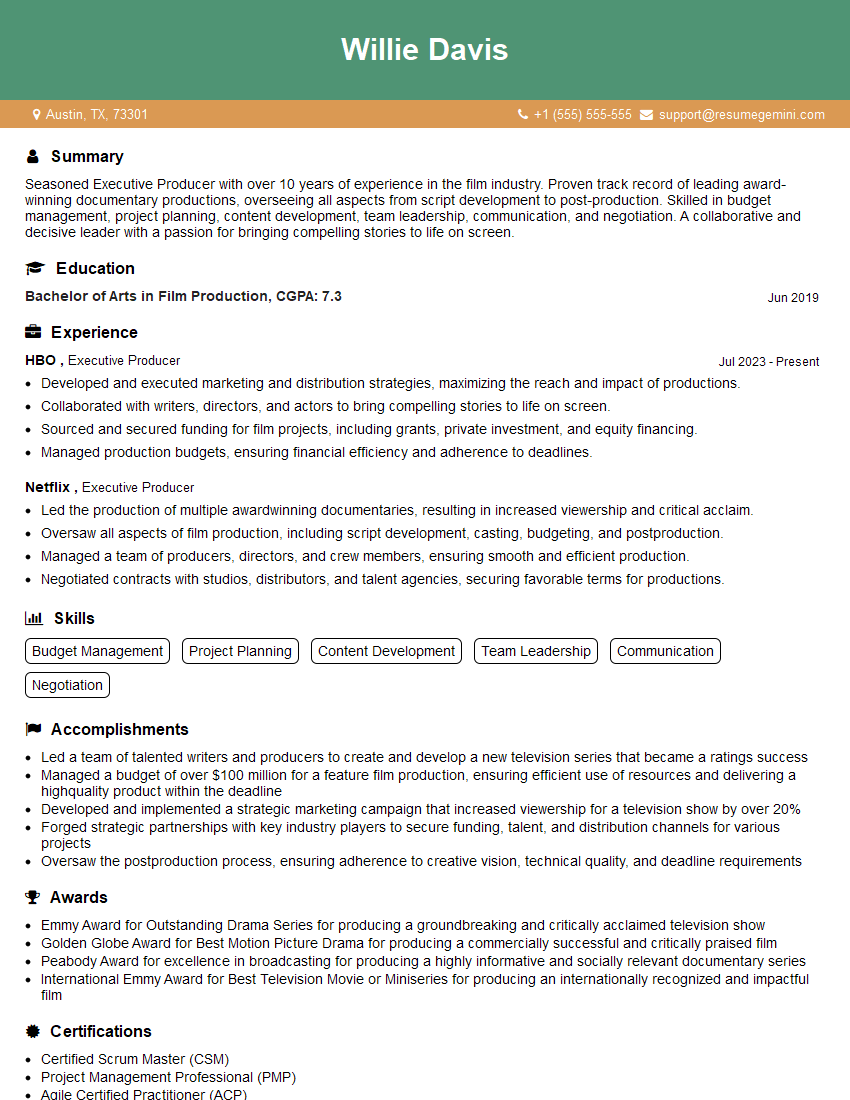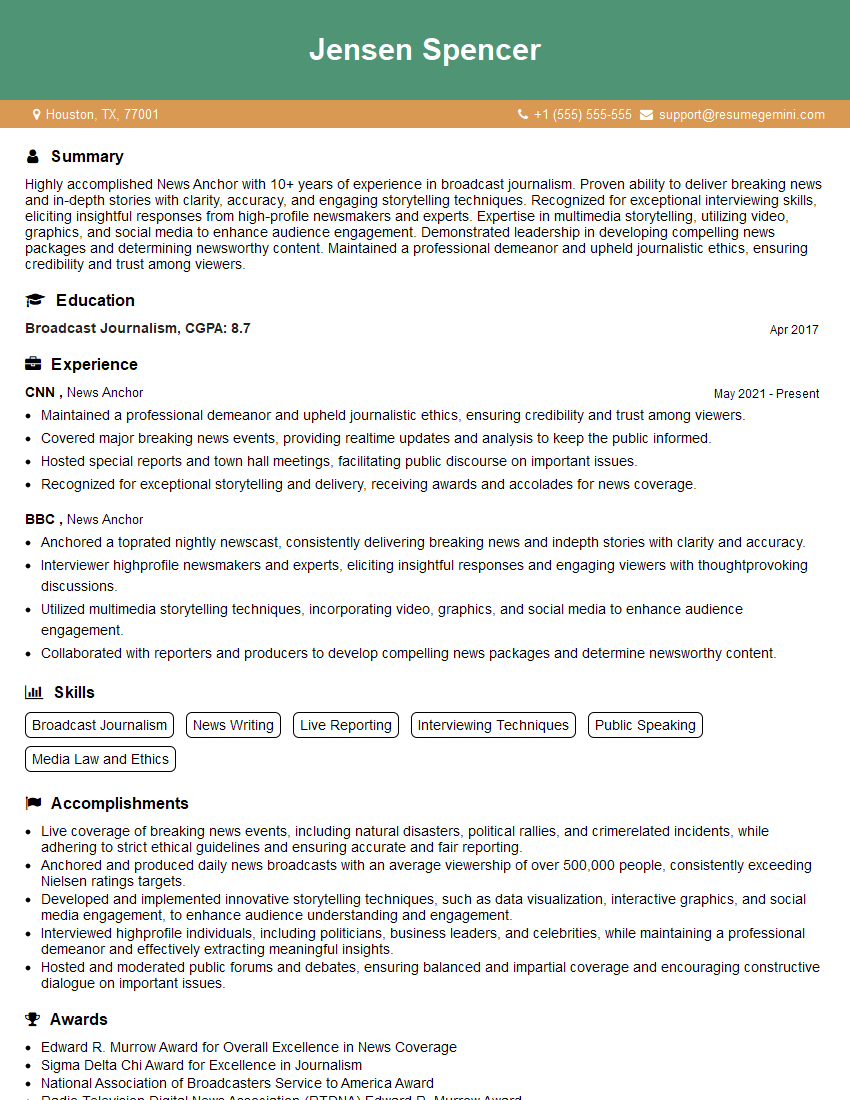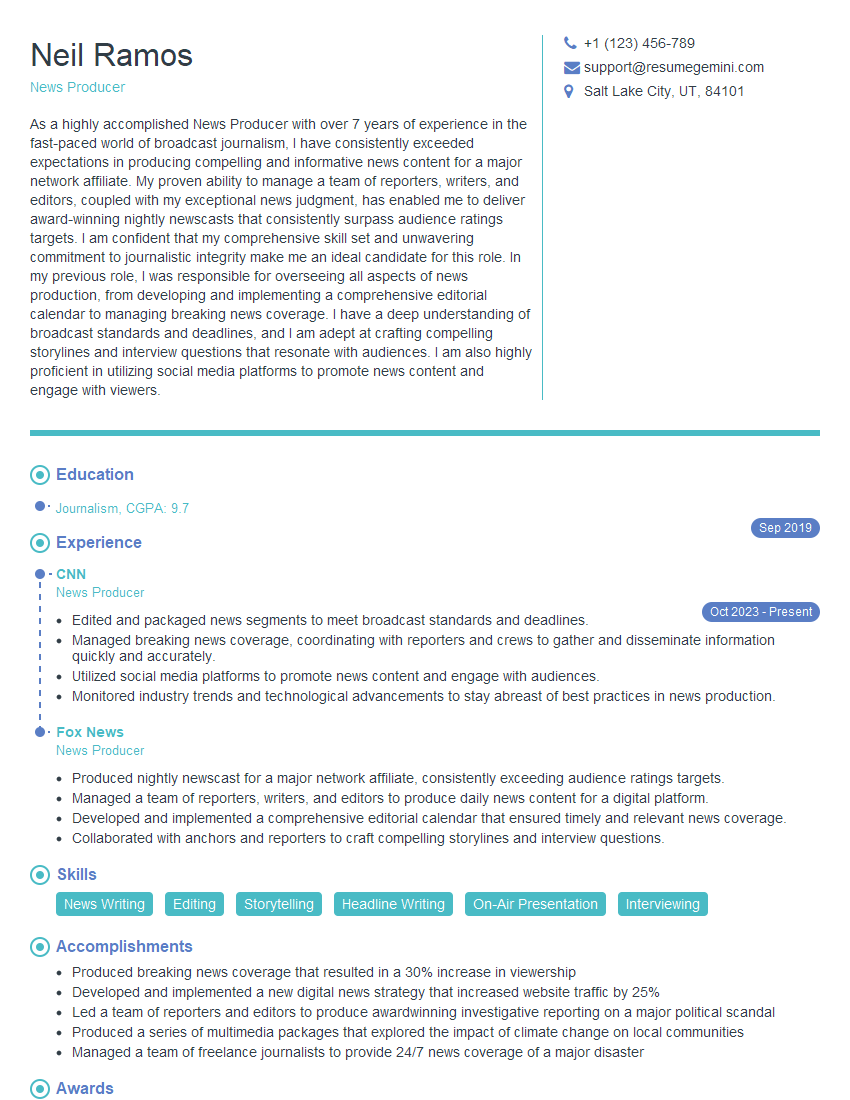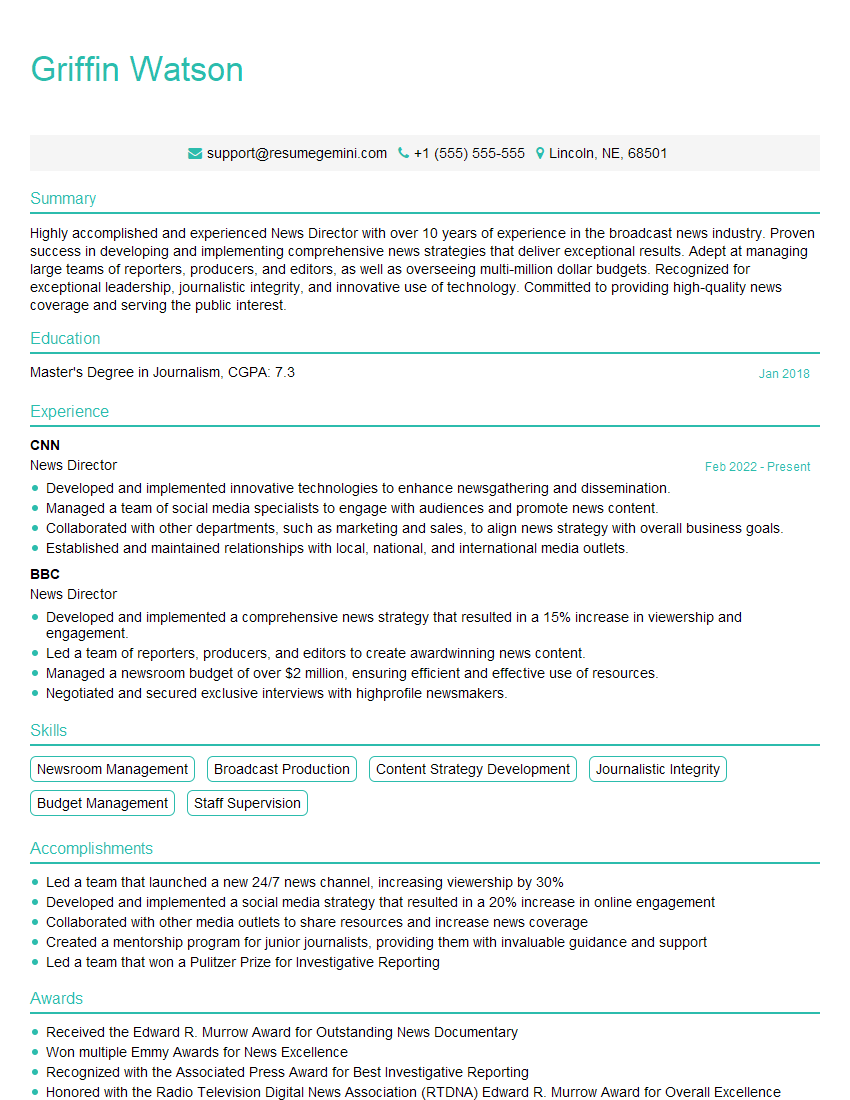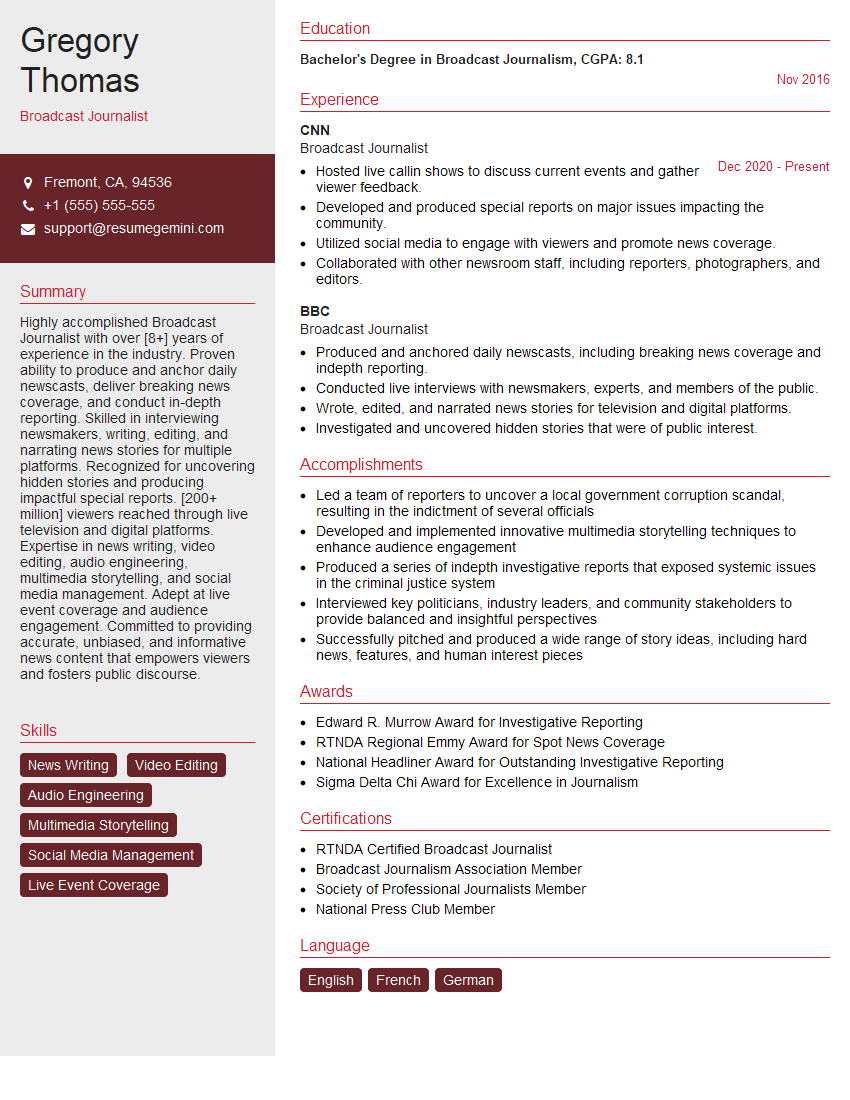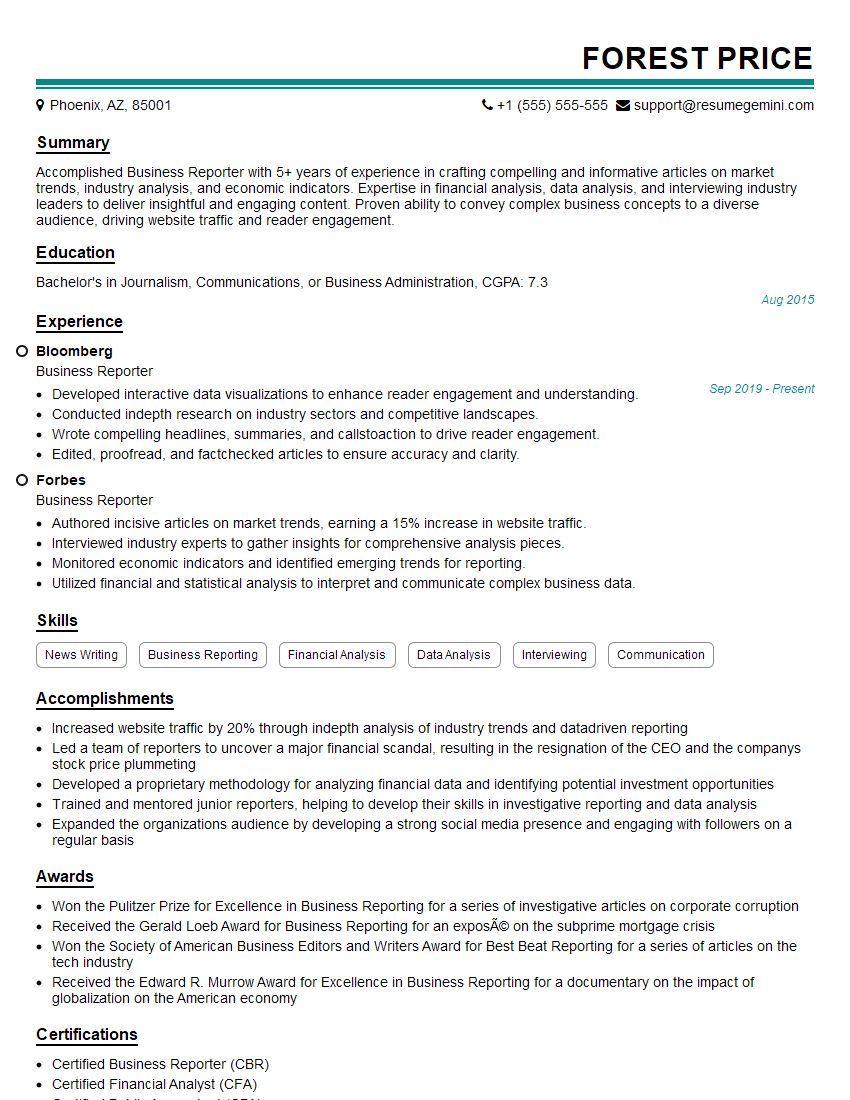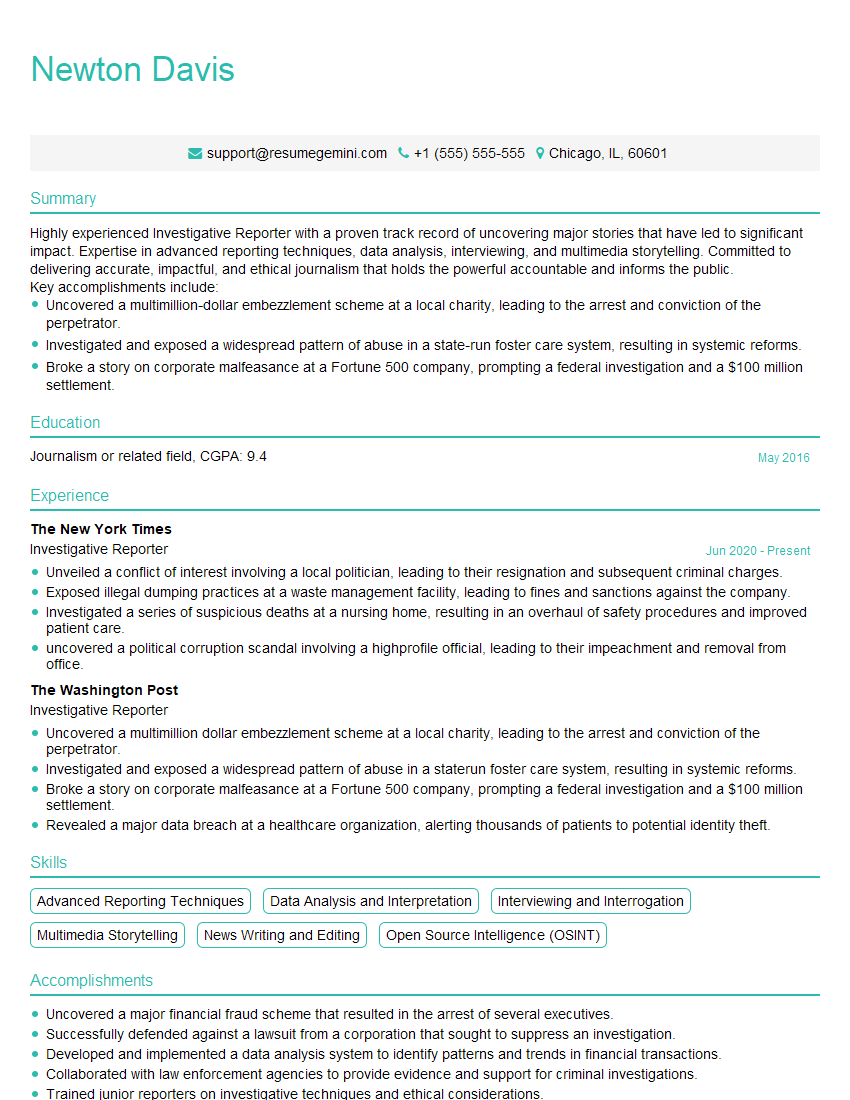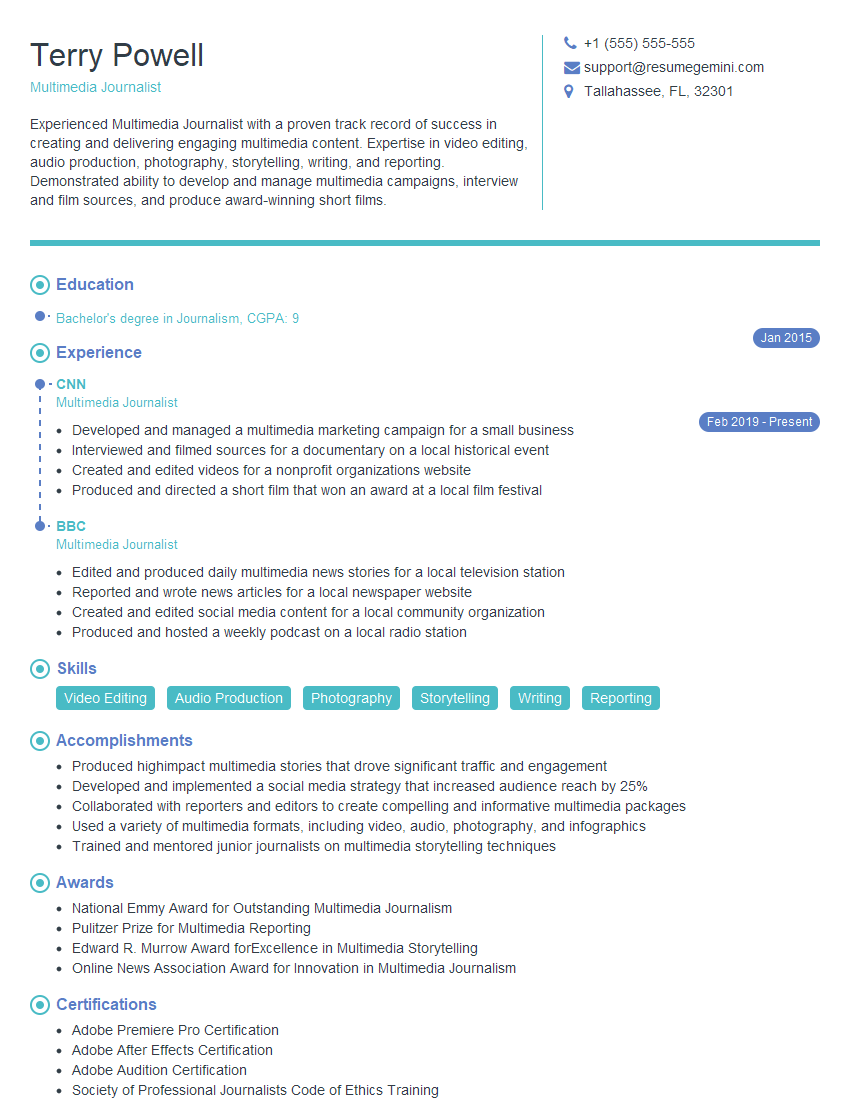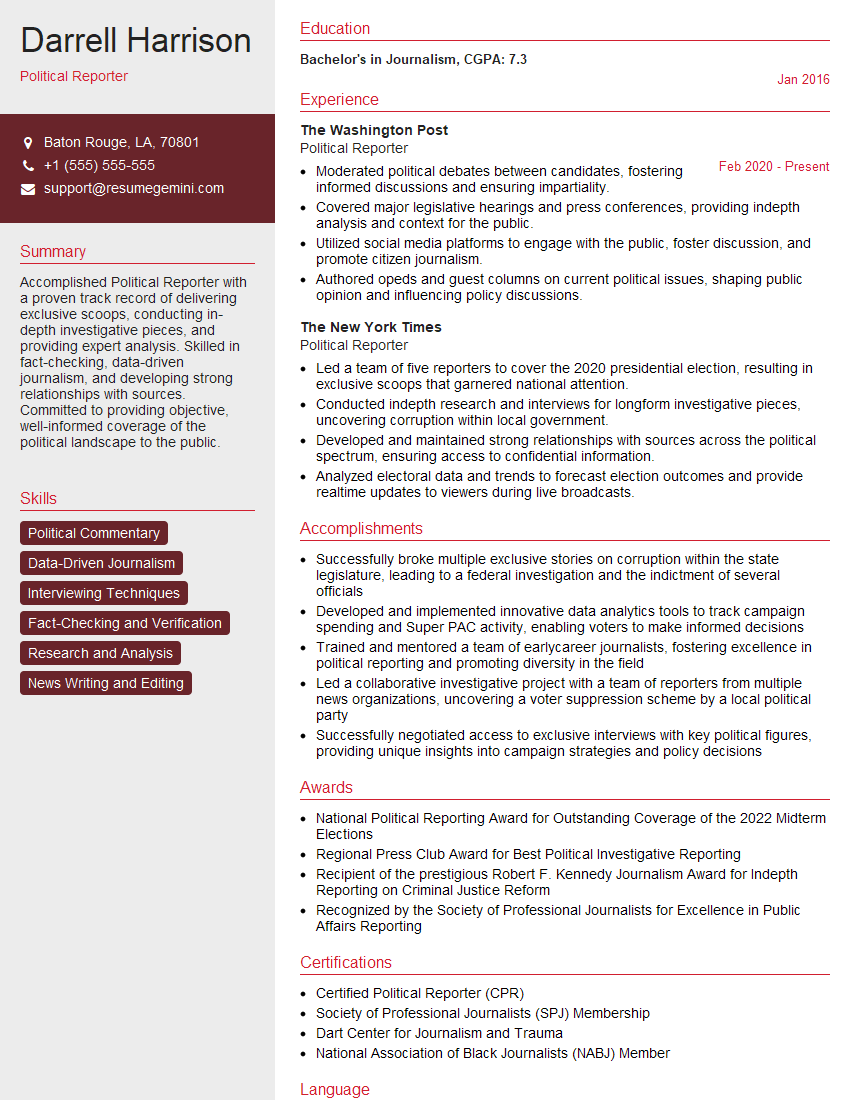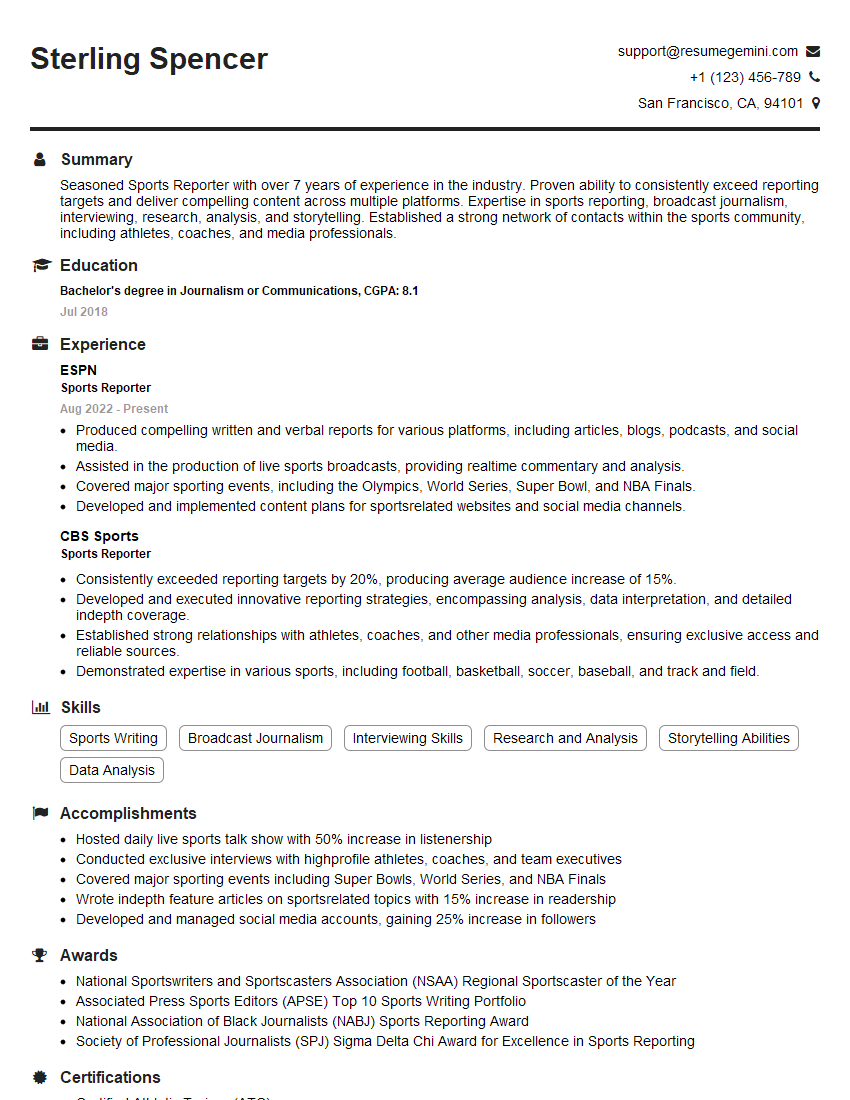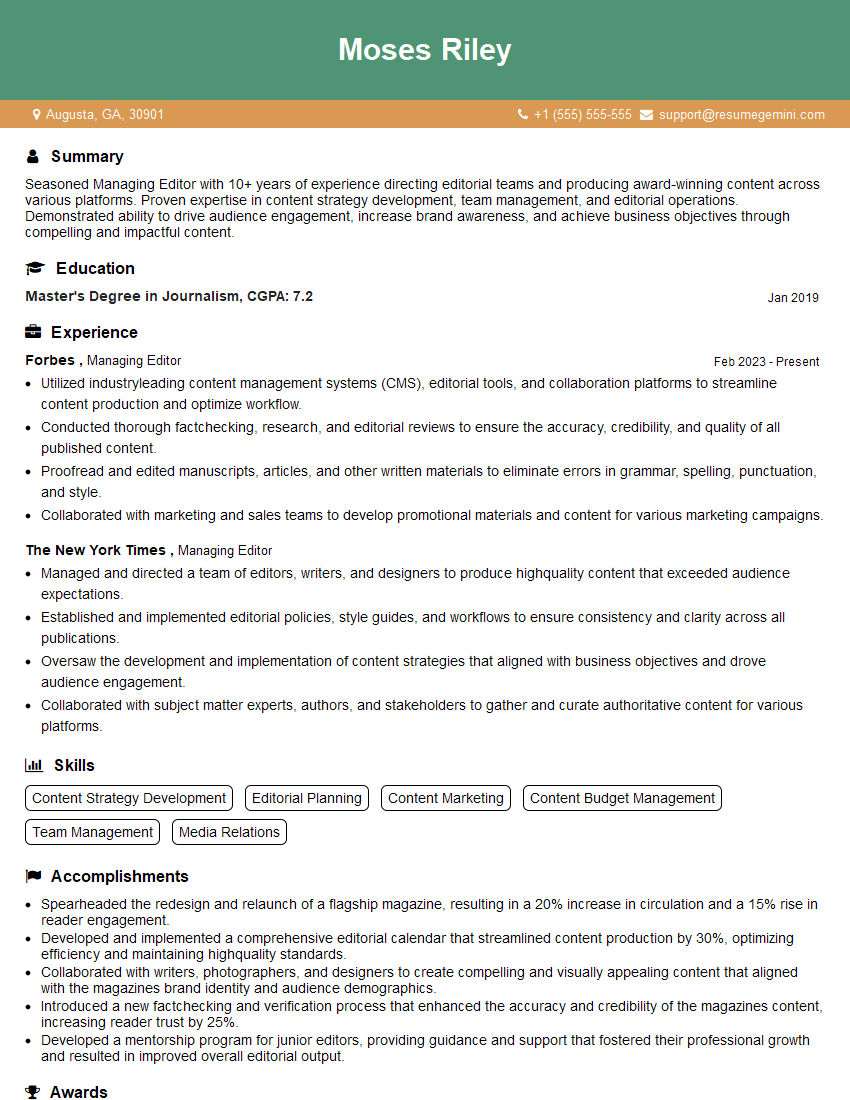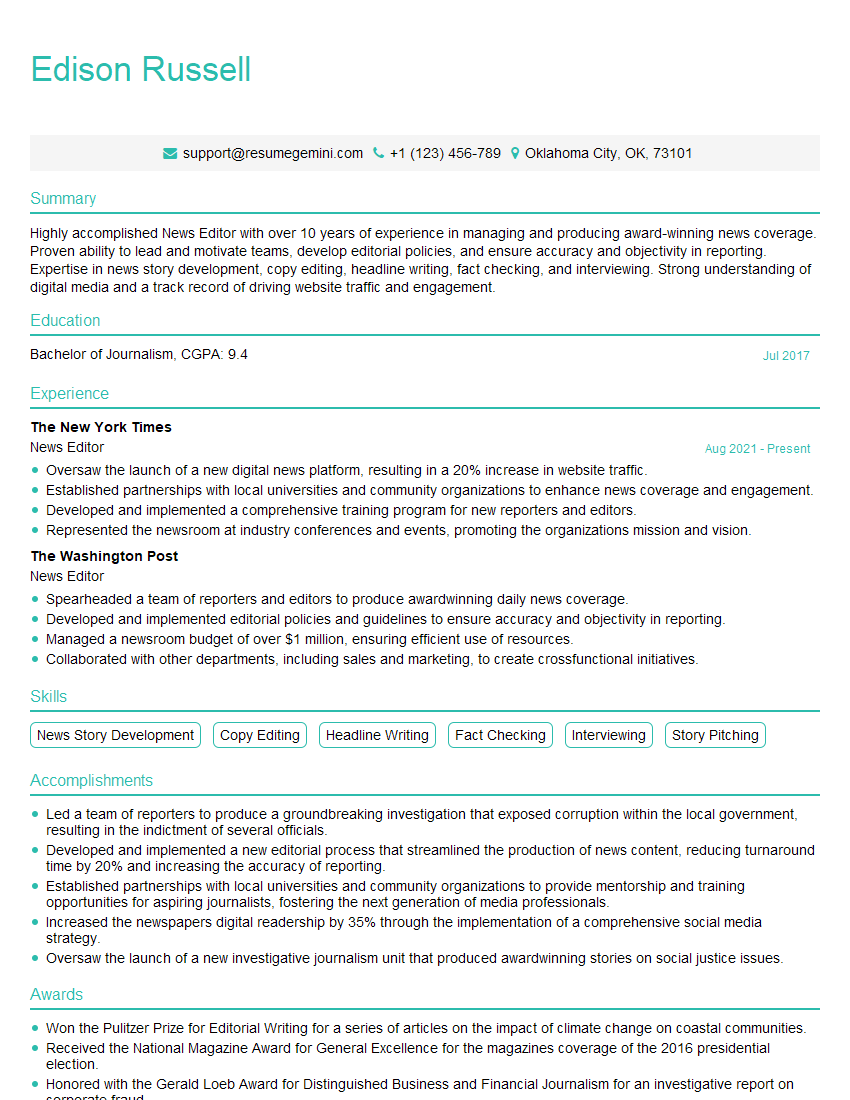Feeling uncertain about what to expect in your upcoming interview? We’ve got you covered! This blog highlights the most important Breaking News Reporting interview questions and provides actionable advice to help you stand out as the ideal candidate. Let’s pave the way for your success.
Questions Asked in Breaking News Reporting Interview
Q 1. Describe your experience covering breaking news events under pressure.
Covering breaking news under pressure is a defining aspect of this profession. It’s a high-stakes environment demanding rapid response, accuracy, and composure under intense time constraints. My experience spans years of covering various events, from natural disasters and political upheavals to major crime scenes. I’ve learned to thrive in this environment by developing a structured approach and leveraging my training in journalistic ethics and reporting techniques. This includes prioritizing information gathering, working efficiently within a team, and maintaining a clear head even amidst chaos. For example, during a major hurricane, we faced power outages and communication disruptions, yet, through collaborative efforts and backup systems, we managed to deliver timely and accurate reports.
I’ve consistently demonstrated an ability to maintain accuracy and professionalism, even when deadlines are incredibly tight and the situation is unpredictable. This involves focusing on the core elements of the story, quickly identifying and prioritizing key details, and staying calm under pressure to ensure the final product is both informative and trustworthy.
Q 2. How do you verify information quickly and accurately in a breaking news situation?
Verifying information swiftly and accurately is paramount in breaking news. It’s about minimizing the spread of misinformation and upholding journalistic integrity. My process involves multiple layers of verification. First, I rely on multiple independent sources – official statements, eyewitness accounts (corroborated whenever possible), and reputable news agencies. Second, I cross-reference information from various sources to identify inconsistencies or biases. Third, I use fact-checking tools and resources available online to verify details like names, dates, and locations. Finally, I employ skepticism and critical thinking, always questioning the reliability and motives of sources.
For instance, during a live breaking news event, if a single source claims a specific casualty number, I would immediately try to confirm it with other reliable sources before reporting it on air. Rushing to report unverified information can be incredibly damaging to a news outlet’s reputation.
Q 3. Explain your process for writing concise and accurate news reports under tight deadlines.
Writing concise and accurate reports under tight deadlines requires a streamlined approach. It’s less about writing beautifully and more about delivering the essential facts clearly and quickly. My process involves the inverted pyramid style of writing: starting with the most important information (who, what, when, where, why) in the lead paragraph, followed by supporting details in descending order of importance. This ensures that even if the story needs to be cut for brevity, the core message remains intact.
I use short, declarative sentences, avoiding jargon and complex language. I also actively focus on eliminating unnecessary words and phrases. Finally, I always review my work carefully for accuracy, grammar, and style before submitting it. Think of it like building a story with the most crucial bricks first. You can always add more later if time allows, but the core structure must be solid from the start.
Q 4. How do you prioritize multiple breaking news stories simultaneously?
Prioritizing multiple breaking news stories simultaneously is a complex juggling act. It involves a strategic assessment of each story’s potential impact, urgency, and news value. I use a system that combines urgency and impact – events with significant consequences and immediate public interest receive top priority. For example, a large-scale disaster would always trump a less significant political development. I also consider available resources – assigning reporters and editors based on expertise and workload. Often, a team approach is crucial to handle multiple stories simultaneously, ensuring every event receives appropriate coverage without compromising accuracy or quality.
I rely heavily on news judgment and experience to make quick decisions about assigning resources and determining the order of coverage.
Q 5. What are your preferred methods for live reporting, and why?
My preferred methods for live reporting include a combination of approaches tailored to the situation. I favor a straightforward, conversational style during live broadcasts, avoiding complex jargon and focusing on clarity. I always utilize multiple camera angles (if available) to offer a comprehensive view of the event. If there are visuals, I’ll describe them while narrating what’s unfolding. For technical aspects, I’m proficient with various broadcast equipment, including teleprompters, microphones, and camera controls.
I find using a teleprompter helps maintain consistency and prevents mistakes under pressure, although I always try to appear natural and engaged rather than robotic. A combination of preparation and adaptability is key to successful live reporting.
Q 6. How do you manage stress and maintain composure during high-pressure breaking news coverage?
Managing stress and maintaining composure during high-pressure situations is crucial. My approach is multifaceted. First, thorough preparation is key. Knowing the story well before going live minimizes anxiety. Second, I prioritize deep breathing exercises and mindfulness techniques to manage stress in real-time. Third, I actively focus on the task at hand, avoiding distractions and maintaining a professional demeanor. Fourth, I rely on my team for support and feedback. Teamwork and mutual support are critical during these high-pressure situations.
Lastly, I remind myself of the importance of the work— informing the public accurately and responsibly— which helps maintain perspective and focus.
Q 7. Describe a time you had to make a quick, critical decision in a breaking news situation.
During a hostage situation, we received conflicting information from various sources. Some reports indicated a peaceful resolution was imminent, while others described an escalating crisis. My quick, critical decision was to refrain from broadcasting unverified details that could compromise negotiations or endanger lives. We instead opted for providing updates based on confirmed information only, emphasizing the importance of accurate reporting, even if it meant a slower news cycle for that particular element.
This decision highlighted the ethical responsibility of prioritizing public safety and accuracy over sensationalism in breaking news reporting. The potential consequences of premature, inaccurate reporting were far too significant to take the risk.
Q 8. How familiar are you with social media’s role in disseminating and verifying breaking news?
Social media has fundamentally reshaped breaking news dissemination and verification. It acts as both a powerful tool and a significant challenge. On one hand, platforms like Twitter and Facebook allow for near-instantaneous updates, bypassing traditional media gatekeepers. Citizen journalists can share firsthand accounts and visuals, enriching coverage significantly. However, this speed comes at the cost of accuracy. Unverified information, misinformation, and even malicious propaganda spread rapidly, requiring careful fact-checking and source verification.
My approach involves a multi-layered strategy: actively monitoring social media for emerging events, cross-referencing information with trusted news sources, and employing reverse image searches and fact-checking websites to verify the authenticity of visuals and claims. I also analyze the credibility of sources based on their past track record and the consistency of their information with other verifiable accounts.
For example, during the 2020 Beirut explosion, initial social media reports were chaotic and contained conflicting details. By carefully analyzing videos, tweets, and statements from multiple sources, including official accounts and reputable news organizations, we were able to construct a more accurate and comprehensive picture of the unfolding events.
Q 9. How do you ensure the accuracy and objectivity of your breaking news reports?
Ensuring accuracy and objectivity in breaking news is paramount. It demands a rigorous and multi-faceted approach. This begins with multiple, independent source verification. We strive to corroborate information from at least two separate, reliable sources before including it in our reports. We also prioritize primary sources—eyewitnesses, officials, documents—whenever possible.
Fact-checking is another critical component. This involves meticulously examining claims, verifying dates, locations, and details, and cross-referencing with established facts and databases. We also remain mindful of potential biases in our sources and strive to present information in a balanced and neutral way, acknowledging different perspectives when appropriate.
Finally, transparency is key. If there are uncertainties or conflicting reports, we clearly state them in our coverage. We don’t shy away from admitting errors and correct them promptly and publicly. This builds trust with the audience.
Q 10. Explain your understanding of journalistic ethics in covering sensitive breaking news.
Journalistic ethics in sensitive breaking news situations are particularly crucial. The principles of truthfulness, accuracy, impartiality, and minimizing harm are paramount. We must always consider the potential impact of our reporting on individuals and communities affected by the event.
This involves careful consideration of language and imagery. We avoid sensationalism or language that could inflame tensions or cause further distress. We also respect the privacy of victims and their families. In cases involving sensitive information, such as investigations into child abuse or crimes of a sexual nature, we exercise extreme caution, ensuring that our reporting does not re-traumatize victims or compromise ongoing investigations.
For instance, when reporting on a mass shooting, we might avoid broadcasting graphic images or identifying victims until their families are notified. Respect for the dignity of those affected is crucial.
Q 11. How do you use different media platforms (TV, online, social) effectively to cover breaking news?
Effective breaking news coverage necessitates a multi-platform approach, leveraging the strengths of different media. Television offers immediacy and visual impact, ideal for live updates and conveying the emotional atmosphere of an event. Online platforms like websites and apps provide the space for deeper analysis, background information, and detailed reports, including multimedia elements such as videos and interactive maps.
Social media plays a significant role in audience engagement and rapid dissemination. It’s a crucial tool for alerting viewers to breaking news, gathering information from the field, and creating direct dialogue with the audience. However, it’s also vital to carefully manage information flowing from social media to ensure credibility.
We employ a coordinated strategy. A breaking news event might start with a brief alert on social media, followed by a live television report offering on-the-ground updates, and concluded with comprehensive online reporting that provides a detailed analysis of the events.
Q 12. Describe your experience with live interviews during breaking news events.
Live interviews during breaking news events are high-pressure situations requiring both composure and rapid thinking. Preparation is critical. I always aim to have a thorough understanding of the event’s context before going live. This involves reviewing available information, identifying key questions, and anticipating potential lines of questioning.
During the interview, clarity and concise communication are paramount. I avoid jargon and explain complex issues in an accessible manner. I remain calm and professional, even when faced with unexpected developments or challenging questions. Active listening is also crucial; I pay close attention to what the interviewee is saying to ensure I ask relevant follow-up questions.
One memorable experience involved a live interview during a major storm. The power was flickering, and the background was chaotic. Maintaining composure while communicating accurate information amidst the chaos was a significant challenge, but ultimately, the experience reinforced the importance of preparation and adaptability.
Q 13. How do you identify and address potential biases in your reporting of breaking news?
Identifying and addressing potential biases is an ongoing and crucial aspect of breaking news reporting. We are constantly mindful of our own potential biases and actively seek to mitigate them. This involves being aware of our personal values, beliefs, and experiences and how they might influence our reporting.
We employ several strategies. We actively seek diverse sources to ensure we’re not relying solely on a single perspective. We examine our language choices for potential bias and strive for neutral wording. We also cross-check information from multiple sources, looking for discrepancies or inconsistencies that might reveal underlying biases. Finally, we utilize blind review processes where possible, asking colleagues to check our work for any unnoticed biases before publication.
Recognizing and acknowledging the limitations of our sources is also essential. If a source has a clear vested interest in an outcome, we highlight this fact to the audience.
Q 14. Describe your experience working with a news team during breaking news coverage.
Working with a news team during breaking news coverage is a highly collaborative effort. Effective teamwork is essential to producing accurate and timely reports. Roles are often fluid and rapidly change based on developing events. We typically have reporters in the field, editors in the newsroom, producers managing broadcast flow, researchers verifying facts, and graphic designers creating visuals.
Communication is key. We rely on instant messaging, internal communication systems, and regular briefings to share information and coordinate efforts. Every member needs to be aware of the latest developments and contribute to a cohesive narrative. Each team member plays a critical role. The success of breaking news coverage often hinges on the seamless coordination and effective communication within the team. Everyone needs to operate with a shared understanding of the priorities and the overall journalistic goal.
A coordinated approach, clear communication, and mutual respect are crucial components of effective teamwork in high-pressure environments.
Q 15. How do you handle conflicting information from multiple sources during a breaking news event?
Handling conflicting information in breaking news is crucial for accuracy and credibility. It’s a multi-step process that prioritizes verification and contextual understanding. First, I meticulously analyze each source, considering its reputation, history, and potential biases. I look for corroboration – do other credible sources report similar information? Discrepancies require deeper investigation. I might try to reach out to additional sources, fact-check claims against official records or statements, and cross-reference data from different sources. If irreconcilable differences persist, I acknowledge the conflict in my reporting, transparently explaining the conflicting information and its sources. For example, during a political rally, one news agency might claim attendance figures of 10,000 while another says 5,000. I wouldn’t simply choose one; I’d explain the discrepancy, citing the sources and perhaps noting any differences in methodology used for counting attendees.
Career Expert Tips:
- Ace those interviews! Prepare effectively by reviewing the Top 50 Most Common Interview Questions on ResumeGemini.
- Navigate your job search with confidence! Explore a wide range of Career Tips on ResumeGemini. Learn about common challenges and recommendations to overcome them.
- Craft the perfect resume! Master the Art of Resume Writing with ResumeGemini’s guide. Showcase your unique qualifications and achievements effectively.
- Don’t miss out on holiday savings! Build your dream resume with ResumeGemini’s ATS optimized templates.
Q 16. Explain your strategies for fact-checking and source verification in breaking news.
Fact-checking and source verification are paramount. My strategies involve a layered approach. I begin by verifying the source’s identity and credibility. Are they a known expert? Do they have a history of accurate reporting? Anonymous sources are treated with extra caution, requiring independent verification. I use multiple sources to cross-reference claims, especially for sensitive or controversial information. Primary sources (eyewitnesses, official documents) are prioritized over secondary sources (reporters, news aggregators). I fact-check all data, dates, locations, and quotes using reliable databases, official websites, and archived materials. Imagine a report of a building collapse. I’d corroborate the location with maps, confirm the number of casualties through official emergency services statements, and potentially consult engineering reports later for the cause if available. If a source provides questionable information, I might attempt to ask follow-up questions to clarify details or confirm accuracy. If I cannot verify something, I won’t publish it.
Q 17. How do you adapt your reporting style to different audiences and media platforms?
Adapting reporting style is vital for effective communication across diverse platforms. Print media often requires a more formal and detailed approach, whereas social media demands brevity and visual appeal. For television, concise language and visual storytelling are key, while radio necessitates clear audio and impactful narration. For example, a print story on a natural disaster might delve deeply into the causes, impacts, and recovery efforts. The same story on Twitter would focus on the most immediate and impactful details, using compelling visuals. Understanding the target audience is also critical – younger audiences might respond better to informal language and storytelling, while older audiences may prefer a more straightforward and traditional style. I tailor my tone, sentence structure, and even vocabulary to effectively reach the specific audience.
Q 18. Describe your experience using newsgathering tools and technologies in breaking news coverage.
Proficiency in newsgathering tools is essential. I’m adept at utilizing social media monitoring tools to track developing events in real-time and identify citizen journalists. I use professional databases like LexisNexis and Westlaw for background information and official records. I frequently utilize mapping software (like Google Maps) to visualize events and track locations. Live-streaming platforms and video editing software are crucial for immediate reporting. During a major protest, for instance, I might use social media monitoring tools to identify videos of the event, verify its location and then potentially use mapping software to show its proximity to sensitive locations. I then cross-reference this information with official police statements.
Q 19. How do you handle corrections and updates to already-published breaking news reports?
Handling corrections and updates requires transparency and responsibility. If inaccuracies or incomplete information surface after publication, I promptly issue corrections or updates, prominently displaying them near the original story. This might involve a simple correction note, a more comprehensive update incorporating new information, or even a complete retraction if necessary. The focus is on acknowledging the error, providing an accurate account, and rebuilding audience trust. For example, if initial reports of casualty numbers in an accident are later revised by official sources, I would clearly indicate the correction, specifying the original number, the revised number, and the source of the update. It’s important to explain *why* the information was incorrect and what steps were taken to arrive at a more accurate figure.
Q 20. How proficient are you in writing headlines and lead paragraphs for breaking news stories?
Writing compelling headlines and lead paragraphs is a critical skill. Headlines need to be concise, accurate, and attention-grabbing, summarizing the core event. Lead paragraphs must immediately establish the who, what, where, when, and why of the story. I strive for clarity and impact. For example, instead of “Incident at City Hall,” a stronger headline would be “Mayor Resigns Amidst Corruption Allegations.” Similarly, a strong lead paragraph would immediately convey the essential information, drawing the reader into the story. I frequently revise my headlines and leads to ensure they accurately reflect the story’s content and capture the reader’s attention without sensationalizing or misrepresenting the facts.
Q 21. Explain your understanding of legal and ethical considerations in breaking news reporting.
Legal and ethical considerations are paramount in breaking news. I am acutely aware of libel laws and the importance of verifying information before publication to avoid spreading misinformation or damaging reputations. Protecting sources’ confidentiality is also crucial; I only reveal sources’ identities with their consent, unless legally required. Maintaining objectivity and avoiding bias is essential, even during highly charged situations. I strive to present all sides of a story fairly and accurately, avoiding sensationalism or manipulative language. For example, in a case of alleged police brutality, I would strive to obtain statements from both the police and the accused individual, and from independent witnesses where available, presenting all versions of events without taking sides before an investigation is concluded. The emphasis is on responsible journalism that serves the public interest.
Q 22. Describe your experience with different news writing styles (inverted pyramid, etc.)
News writing styles are crucial for effectively conveying information. The inverted pyramid, my most frequently used style, prioritizes the most important information at the beginning—who, what, when, where, why, and how—followed by progressively less crucial details. This ensures readers grasp the essence of the story quickly, even if they don’t read the entire piece. Other styles I utilize include the narrative style, which tells a story with characters and a plot, more suitable for feature-length pieces, and the hourglass style, which starts with an inverted pyramid structure then transitions to a narrative before concluding with a summary.
For instance, in a breaking news report about a building fire, the inverted pyramid would begin with: “A major fire broke out at 10:00 AM today at the Acme Building on Main Street, leaving five people injured.” Subsequent paragraphs would elaborate on details such as the cause of the fire, the extent of the damage, and rescue efforts. This is in stark contrast to a narrative approach that might begin with a description of a firefighter’s experience battling the blaze.
Q 23. How do you maintain your credibility and build trust with sources during breaking news events?
Credibility and trust are paramount in breaking news. I build rapport with sources by being transparent, respectful, and demonstrating journalistic ethics. I clearly state my role and affiliation, always obtain informed consent before using their information and, critically, honoring any requests for anonymity when justified. Building trust is an ongoing process; consistently delivering accurate, fair, and timely reporting strengthens the relationships with sources. I am mindful of their time constraints during stressful events and prioritize clear, concise communication.
For example, during a breaking news event involving a natural disaster, I might contact local emergency personnel to gather information. To build trust, I would clearly introduce myself, explain my news outlet and the purpose of my inquiry, listen carefully to their concerns, and respond promptly to their questions.
Q 24. How familiar are you with AP style and other journalistic style guides?
I am very familiar with AP style and other journalistic style guides, including Chicago and MLA. AP style is the foundation of my writing. Understanding these style guides ensures consistency, accuracy, and clarity in my reporting. I adhere to rules on capitalization, punctuation, numbers, abbreviations, and data presentation. Consistency in these elements enhances the reader’s understanding and maintains professional standards.
For instance, I understand that AP style dictates using numerals for numbers 10 and above (10 cars) but spelling out numbers one through nine (nine injured). This seemingly minor detail contributes to the overall professionalism and readability of the news report.
Q 25. Explain your experience using video editing software for breaking news packages.
I’m proficient in several video editing software packages, including Adobe Premiere Pro and Final Cut Pro. My experience encompasses assembling breaking news packages: selecting relevant footage, adding graphics, incorporating B-roll, and composing compelling narratives under time pressure. I prioritize fast turnaround without sacrificing quality, ensuring the packages are engaging and informative for viewers.
In a recent breaking news situation concerning a political rally, I used Premiere Pro to assemble a package using a mix of live footage, interviews, and archival material. I created a dynamic sequence that provided context and kept viewers engaged despite the time constraints. Skillful editing is crucial to maintain the audience’s attention amid the chaos of a breaking news event.
Q 26. How do you effectively collaborate with photographers and videographers during breaking news coverage?
Collaboration is essential in breaking news. Before an event, I discuss coverage strategies with photographers and videographers. During coverage, I maintain constant communication through a variety of methods: walkie-talkies, phones, and text messages. This ensures coordinated efforts and optimized use of resources. The objective is to capture multiple perspectives for a complete and multifaceted story.
For example, during a protest, I would brief the photographer and videographer on the planned route of the march, key locations to capture footage, and potential points of interest. During the event, I would communicate any changes in the situation, potential risks, and updates on the evolving story, coordinating shots and ensuring safety for the team.
Q 27. How do you balance speed and accuracy in breaking news reporting?
Balancing speed and accuracy is the core challenge in breaking news. My approach involves a multi-step process: prioritizing initial verification of facts from multiple reliable sources, drafting a concise but accurate initial report, updating the story as more verified information becomes available, and correcting any errors immediately. Fact-checking and multiple source verification are non-negotiable.
Think of it as a race where accuracy is the finish line. Getting there first is important, but crossing the line with incorrect information renders the entire effort pointless. A thorough, accurate report, even if slightly delayed, has more value than a fast, inaccurate one.
Q 28. Describe a situation where you had to work independently under time constraints during breaking news.
During a severe weather event, I was the sole reporter covering a specific area. The power grid failed, cell service was sporadic, and I was facing time constraints to deliver a report on the extent of the damage and impact on the community. I relied on a satellite phone for communication and used a portable generator for power, while carefully documenting the scene and gathering information from local residents.
This required resourceful improvisation. Despite technological limitations, I prioritized accurate information gathering and produced a timely report. This highlighted the importance of adaptability, resourcefulness, and prioritizing essential information under pressure. Thorough preparation and planning are also key—knowing how to utilize alternative technology during power outages is vital.
Key Topics to Learn for Breaking News Reporting Interview
- News Gathering and Verification: Understanding the importance of multiple sources, fact-checking techniques, and verifying information quickly and accurately in a high-pressure environment.
- Writing for Speed and Accuracy: Mastering concise and clear writing styles, adapting to different platforms (print, online, broadcast), and prioritizing accuracy above all else.
- Live Reporting Techniques: Developing skills in delivering breaking news updates live on air or online, maintaining composure under pressure, and effectively communicating complex information concisely.
- Ethical Considerations: Understanding journalistic ethics, responsible reporting, and the implications of bias and misinformation in breaking news coverage.
- Digital Media and Social Media: Leveraging social media for news gathering, verification, and dissemination; understanding the unique challenges and opportunities presented by digital platforms.
- Storytelling and Narrative Structure: Structuring breaking news reports effectively to engage audiences, crafting compelling narratives within time constraints, and prioritizing clarity and impact.
- Crisis Communication and Risk Management: Understanding how to navigate sensitive situations, manage potential risks associated with breaking news, and maintain journalistic integrity.
- Technical Skills: Familiarity with newsroom technology (CMS, editing software, social media management tools), and ability to adapt quickly to new technologies.
Next Steps
Mastering breaking news reporting is crucial for career advancement in journalism. It demonstrates your ability to handle high-pressure situations, deliver accurate information quickly, and adapt to the ever-evolving media landscape. This skillset is highly valued by news organizations and opens doors to exciting opportunities for growth. To significantly boost your job prospects, crafting an ATS-friendly resume is essential. ResumeGemini is a trusted resource that can help you build a professional and impactful resume, ensuring your qualifications stand out. Examples of resumes tailored to Breaking News Reporting are available to guide you through the process.
Explore more articles
Users Rating of Our Blogs
Share Your Experience
We value your feedback! Please rate our content and share your thoughts (optional).
What Readers Say About Our Blog
Hi, I represent an SEO company that specialises in getting you AI citations and higher rankings on Google. I’d like to offer you a 100% free SEO audit for your website. Would you be interested?
Hi, I represent an SEO company that specialises in getting you AI citations and higher rankings on Google. I’d like to offer you a 100% free SEO audit for your website. Would you be interested?
Dear Sir/Madam,
Do you want to become a vendor/supplier/service provider of Delta Air Lines, Inc.? We are looking for a reliable, innovative and fair partner for 2025/2026 series tender projects, tasks and contracts. Kindly indicate your interest by requesting a pre-qualification questionnaire. With this information, we will analyze whether you meet the minimum requirements to collaborate with us.
Best regards,
Carey Richardson
V.P. – Corporate Audit and Enterprise Risk Management
Delta Air Lines Inc
Group Procurement & Contracts Center
1030 Delta Boulevard,
Atlanta, GA 30354-1989
United States
+1(470) 982-2456
